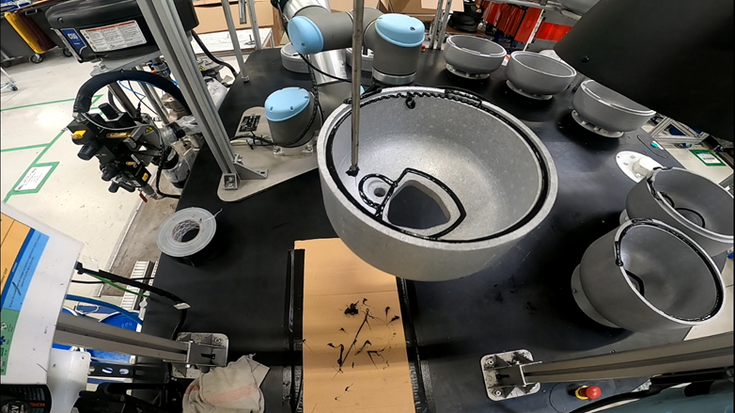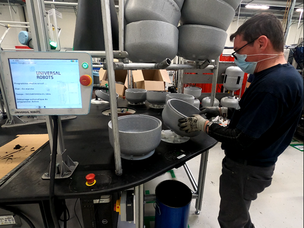Ultima Forma
항공 제조의 미래 만들기
In short
JL CORP , official integrator of Universal Robots in Hauts de France, has created a gluing solution for the ATLANTIC Group , on its production site in Billy-Berclau, in Nord Pas-de-Calais. This automated solution, used in the preparation of a sub-assembly of heat pumps, is directly integrated into the production line. The latter has a dual objective: to reduce the arduousness of work and increase productivity without causing any inconvenience to operators.
Enhancing productivity and ergonomics in heat pump assembly
ATLANTIC, a leader in thermal comfort (heating, ventilation and air conditioning), wanted to improve productivity at a workstation gluing stainless steel tank shells for its heat pumps, in order to support customer demand and market development.
The polystyrene shell acts as an insulator to prevent condensation and rust from forming on the stainless steel tank. The gluing has a significant impact on the product's lifetime warranty because it blocks air permeability.
Manual operations could no longer keep up with the increasing volume required while maintaining the required level of quality. The development and integration of the application was carried out by JL CORP at the Billy-Berclau production site. This site, which employs around 250 people, produces 80,000 heat pumps and 50,000 boilers per year.
The position in question presented several challenges: overcoming the risk of MSDs (the operator had to perform the same movements up to 200 times a day) and cleanliness, as the operation was very dirty, particularly because of the sealant. This gluing cell is included in a global robotization project for the company's activities, which also includes welding cells.
JL Corp
Main Value Levers:
Operating safely alongside operators Fast ROI, minimal maintenance Position duplication capacity
Tasks Solved Using Collaborative Robots:
Reduction of MSDs of operators by performing a physically demanding task Precision of diffusion and dosage of glue by the cobot Recognition of references via a camera Improving productivity and quality Saving on glue usage
Automation Challenges Solved:
Gluing of balloon shells for stainless steel tanks Complete autonomy on the workstation Compactness of the workstation resulting in space savings
How they did it

Collaborative robotics for precision and efficiency
The ATLANTIC Group therefore turned to the cobotics specialist Universal Robots in its region: JL CORP. The solution, based on a UR10, had to be able to keep up with the increase in volume required by the site, while being compact and secure.
JL CORP leveraged its experience in integrating cobotic solutions into production lines, supporting the Atlantic Group through all stages of the process.
Originally, the operator responsible for gluing the hulls processed 90 pieces per 8-hour period. He held the hull in one hand and the mastic gun in the other, and carried out the operation manually, having to be careful to use the right amount of glue in the right place, and regularly, respecting a precise pattern.

An automated and optimized workstation
The automated workstation consists of a large semi-circular table, on which a UR10 cobot operates. The cobot operates in front of 8 stands on which the operators place the half-shells to be glued. The cobot is equipped with a gripper developed by JL CORP, 3D printed and with foam edges, as well as a central suction cup, allowing it to grip the polystyrene shells without deformation, the latter weighing only 200 grams. The station also includes a central and overhead Sensopart camera (which performs quality inspection and checks if the shell is compliant) as well as a nozzle that dispenses the glue.

A fully autonomous cobot
The cobot handles the operation alone, without the need for human intervention. This is limited to placing the shells to be glued and starting the cycle. When the operator presses the button in front of a shell, the cobot grabs it and presents it to the central camera. It then examines the shell and sends a signal to the robot: if the shell is not already glued, the robot will then bring the shell under the nozzle, which will deposit the glue following the requested pattern. The cobot then returns under the camera to check whether the bonding is compliant. If it is, the cobot places the shell back on its original base. If it is not, the cobot places the shell in a space in the center to discard the non-compliant part.
The cobot only works on three gluing references: the upper part, the lower part, and a central ring, used for certain models of balloons.

A secure and reliable solution
JL CORP specifically designed the cell so that it is the cobot that moves the shell and not the 4 mm glue nozzle that moves, which represented a much greater danger. In the application, the cobot, even with its arm outstretched, cannot exceed its semi-circular operating perimeter. The station is thus calibrated so that the robot cannot reach the operators moving around it, eliminating any risk of collision. Even in the event of an impact, the extremely low impact (60 newtons) makes the cobot completely safe. The solution is therefore 100% secure and integrates perfectly into the production line.
In the event of a problem (empty glue tank, falling part), the cobot alerts the operator, who intervenes.

A compact, cost-Effective, and high-impact automation solution
The installation delivered by JL CORP met all of the ATLANTIC group's needs. In addition to freeing operators from a physically tiring task, the cobot reduced glue consumption by 30 to 40%, thanks to its repeatable dosage. This repeatability led to improved glue application, and therefore, the quality of the final product and its lifespan.
The cobot has increased the site's productivity, being able to glue 140 parts per eight-hour cycle, an increase of more than 50% compared to the manual cycle. Operators have taken ownership of the cobot and supervise its work themselves, ensuring process continuity by greatly reducing interruptions. They devise trajectory evolutions to optimize new developments. There is almost no maintenance required on the cobot itself, only its accessories.
Another advantage: the solution's compactness. Since the cobot poses no danger to operators, the addition of protective cages or safety barriers was not necessary. This allowed the Atlantic group to save space and integrate this gluing station into the existing workshop.
The solution was delivered by JL CORP just 4 months after the order was placed, and paid for itself in just 6 months, twice as fast as a traditional industrial robotics solution. The cobot now assembles 200,000 hulls per year.
Given the success of this investment and the changing demand for heat pumps, the Atlantic group plans to duplicate this position in the near future.
Sébastien Dorez, Business Manager at JL CorpUR10 모델에서 가장 인상 깊었던 점은 설정의 용이성입니다. 저는 매우 기본적인 코딩 경험으로 이 일을 시작했고, 로봇 공학 경험이나 코봇 (cobots) 은 전혀 경험하지 못했습니다. 그러나 우리는 팔을 상자에서 꺼내 몇 시간 만에 기본 수준으로 올리고 실행했습니다.
Start Your Project Now
Universal Robots and its distributors will visit your premises for a demonstration and advice.
유니버설 로봇과 연락하세요
수천 개의 기업이 협동 로봇을 활용하여...
- 생산성 향상
- 변화하는 제품 수요에 적응
- 직원 복지 및 유지 개선
- 노동력 부족 문제 해결
- Universal Robots Korea
- #302, Pankyo Innovalley B
- 253, Pangyo-ro, Bundang-gu, Seongnam-si, Gyeonggi-do, Korea



